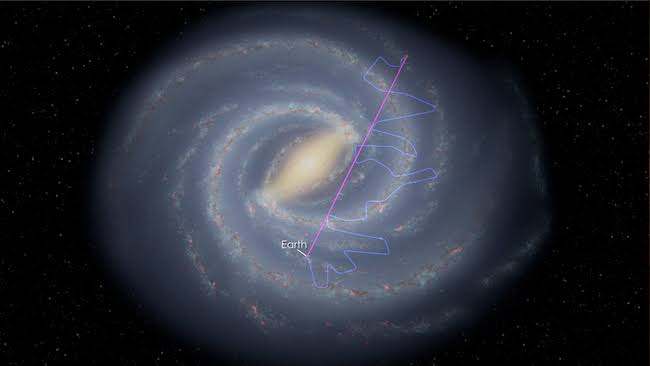The mysteries of the universe are vast and complex, spanning various areas such as dark matter, dark energy, galaxy formation, and the behaviour of black holes. However, Cosmic Rays hold the potential to unlock some of the universe’s mysteries, according to scientists. Cosmic rays consist of high-energy particles originating from sources outside our solar system. By detecting and studying these particles, scientists can gain insights into the composition and behaviour of the universe.

Recent post: Space Weather And Its Effects On Earth
So, what are Cosmic Rays and how are they Formed?
Cosmic rays are atomic fragments that constantly bombard the Earth from beyond our solar system. These particles possess extremely high energy and travel through space at nearly the speed of light. Although cosmic rays are predominantly composed of protons (89%), which are the lightest and most abundant element in the universe, they also contain helium nuclei (10%) and heavier elements (1%), including uranium.
Cosmic rays were first discovered in the year 1912. Even after more than 100 years of study, the origin of cosmic rays is still a subject of ongoing research and debate among scientists. Cosmic rays are formed by a variety of mechanisms, both within and outside our galaxy.
Some cosmic rays are produced in our own Milky Way galaxy, through the shock waves produced by supernova explosions, which can accelerate protons and other particles to high energies. However, a significant portion of cosmic rays are believed to originate from outside our galaxy and may be generated by supermassive black holes, active galactic nuclei, or gamma-ray bursts.
Journey to Earth, Detection and Study:
Due to their charged nature, cosmic rays such as positively charged protons and nuclei, or negatively charged electrons, can be influenced by magnetic fields during their travels through space. As a result, their paths can be distorted, making it difficult to trace their exact origins. The magnetic fields of the galaxy, solar system, and Earth can all affect the paths of cosmic rays, leading to significant deviations from their original trajectories. Thus, scientists rely on indirect methods to determine the sources of cosmic rays.

Direct observation of cosmic ray particles on Earth’s surface is not possible since the primary particles collide with atmospheric nuclei and produce secondaries. Secondaries include fragments of the colliding nuclei, such as neutrons, and short-lived particles generated from the energy of the collisions. These secondaries, like muons and neutrons, are the particles that can be detected at sea level.
The primary particles themselves can only be studied through high-altitude balloons such as through the Super Trans-Iron Galactic Element Recorder (SuperTIGER) or spacecrafts like Fermi Gamma-ray Space Telescope which was used to detect gamma rays produced by cosmic ray interactions in space, which can observe them at the outer edge of Earth’s atmosphere before they collide with atmospheric nuclei and produce secondaries.
Cosmic Rays and their impacts on Earth:
Cosmic rays can have several impacts on the Earth, ranging from minor disruptions to electronic equipment to potential risks to human health.
These rays create secondary particles, such as protons, neutrons, and muons, when they collide with the Earth’s atmosphere, leading to the formation of ions and free electrons that can affect weather patterns and contribute to cloud formation, which can alter the Earth’s climate. However, more research is supposed to be done about how cosmic radiation can impact Earth’s weather.
The effects of cosmic rays on human health are also a concern, especially for people who are exposed to higher levels of cosmic radiation, such as astronauts and airline passengers. These rays can pass through shielding materials, including aircraft cabins and spacecraft hulls, and harm DNA, potentially causing cancer.
Opportunities:
Despite the potential dangers, cosmic rays have also brought significant advancements in technology and scientific understanding.
Research on cosmic rays has been instrumental in exploring the world of subatomic particles. In fact, the study of cosmic rays has allowed scientists to discover particles that were previously unknown, such as the positron (the antielectron), which was first observed in 1932.
Other particles like the muon and the pion were also discovered through cosmic ray research. This natural radiation was the only means of investigating the rapidly expanding particle “zoo” until the development of high-energy particle accelerators in the early 1950s. The discovery of these particles has led to a greater understanding of the fundamental building blocks of matter and has revolutionized the field of particle physics.
Additionally, cosmic ray research has practical applications in fields such as medicine, as it can be used for cancer therapy and radiation protection. Overall, studying cosmic rays presents an exciting and promising avenue for scientific advancement.
Conclusion
In conclusion, cosmic rays are a fascinating and complex phenomenon with significant implications for both humans and technology in space. While they pose some challenges to space travel and exploration, they also provide valuable insights into the workings of the universe and offer opportunities for scientific advancement.
As we continue to push the boundaries of space exploration, it is essential to continue studying cosmic rays and their effects on humans and technology. By doing so, we can develop strategies for future space missions and discoveries.
